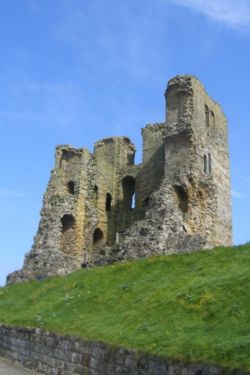Castle: Difference between revisions
imported>Caesar Schinas m (misused credit line) |
imported>John Stephenson (update templates) |
||
| Line 5: | Line 5: | ||
While a [[fort]] may well be a simple, temporary structure, frequently with a [[military]] focus, castles were often at the heart of [[Middle Ages|medieval]] communities. A castle might well have served as a focal point for [[trade]] as well as [[war]]fare, and a settlement would grow in or around its grounds. The local lord would collect [[tax]]es from local folk in return for the castle's protection. In wartime, [[siege]]s could go on for months or even years, with the castle's defenders surviving on water drawn from the castle's own wells, and food stockpiled in its chambers. | While a [[fort]] may well be a simple, temporary structure, frequently with a [[military]] focus, castles were often at the heart of [[Middle Ages|medieval]] communities. A castle might well have served as a focal point for [[trade]] as well as [[war]]fare, and a settlement would grow in or around its grounds. The local lord would collect [[tax]]es from local folk in return for the castle's protection. In wartime, [[siege]]s could go on for months or even years, with the castle's defenders surviving on water drawn from the castle's own wells, and food stockpiled in its chambers. | ||
[[Image:Himeji Castle.jpg|left|thumb|250px| | [[Image:Himeji Castle.jpg|left|thumb|250px|Sixteenth-century [[Himeji Castle]] is a UNESCO [[World Heritage site]]; unusually for Japan, the castle is built of wood rather than stone.]] | ||
A variety of building materials would be used to construct a castle, and successive owners might have made many improvements or modifications. In [[Europe]], although [[wood]] structures existed, there was a move towards [[stone]] for greater protection. For example, while the first known castle at [[Scarborough, North Yorkshire|Scarborough]], [[England]] was made of wood, its replacement, the existing [[Scarborough Castle]], was built of stone.<ref>Binns (2002: 15-16).</ref> On the other side of the world, many castles were built in [[Japan]], typically also of wood. An exception is [[Himeji Castle]], which was built of wood and [[fire]]proof plaster.<ref>''Himeji Castle'': '[http://www.himeji-castle.gr.jp/index/English Virtual Tour - Himeji Castle]'.</ref> | A variety of building materials would be used to construct a castle, and successive owners might have made many improvements or modifications. In [[Europe]], although [[wood]] structures existed, there was a move towards [[stone]] for greater protection. For example, while the first known castle at [[Scarborough, North Yorkshire|Scarborough]], [[England]] was made of wood, its replacement, the existing [[Scarborough Castle]], was built of stone.<ref>Binns (2002: 15-16).</ref> On the other side of the world, many castles were built in [[Japan]], typically also of wood. An exception is [[Himeji Castle]], which was built of wood and [[fire]]proof plaster.<ref>''Himeji Castle'': '[http://www.himeji-castle.gr.jp/index/English Virtual Tour - Himeji Castle]'.</ref> | ||
==Footnotes== | ==Footnotes== | ||
{{reflist|2}} | |||
Revision as of 04:19, 18 September 2009

A castle is a building which was designed to protect people and property inside, and typically belonged to an important or wealthy person such as a lord or monarch. Castles are strongly associated with previous eras of history, when everyday life was more dangerous for individuals than now, and today most castles are either forgotten ruins or tourist attractions.
While a fort may well be a simple, temporary structure, frequently with a military focus, castles were often at the heart of medieval communities. A castle might well have served as a focal point for trade as well as warfare, and a settlement would grow in or around its grounds. The local lord would collect taxes from local folk in return for the castle's protection. In wartime, sieges could go on for months or even years, with the castle's defenders surviving on water drawn from the castle's own wells, and food stockpiled in its chambers.

A variety of building materials would be used to construct a castle, and successive owners might have made many improvements or modifications. In Europe, although wood structures existed, there was a move towards stone for greater protection. For example, while the first known castle at Scarborough, England was made of wood, its replacement, the existing Scarborough Castle, was built of stone.[1] On the other side of the world, many castles were built in Japan, typically also of wood. An exception is Himeji Castle, which was built of wood and fireproof plaster.[2]
Footnotes
- ↑ Binns (2002: 15-16).
- ↑ Himeji Castle: 'Virtual Tour - Himeji Castle'.